This post may contain affiliate links. Learn more.
Here’s how to cure salmon at home, with just a few minutes of hands-on time. It sounds (and will appear) wildly impressive, but this gravlax recipe couldn’t be easier.
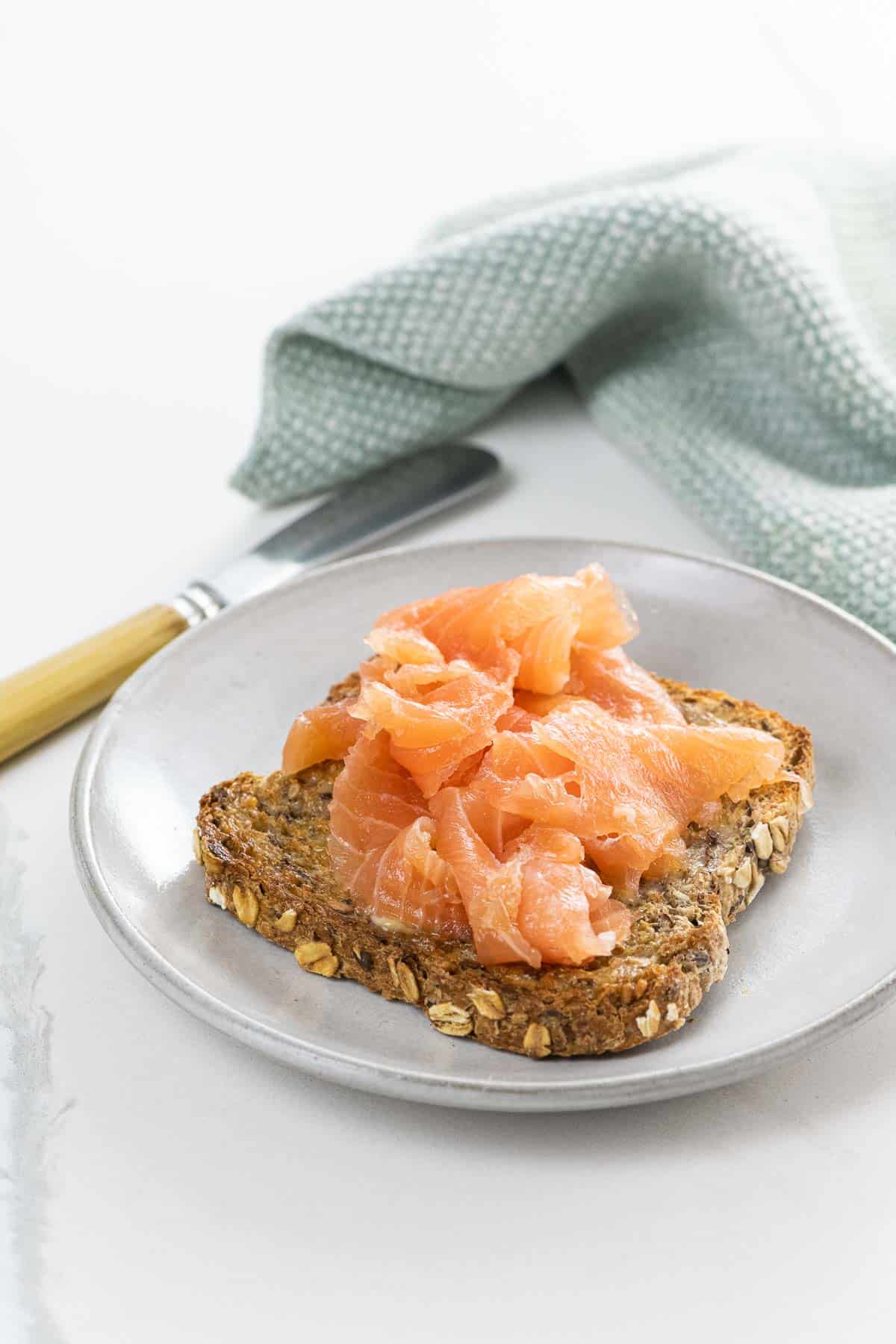
Why we love this recipe
I love gravlax even more than smoked salmon. It tends to have a more delicate, nuanced flavor profile that lets the salmon itself shine through. Truth be told, had I not been to culinary school, I don’t know that I would have been brave enough to learn how to cure salmon at home. The thing is, though, it’s seriously easy.
Over the years I’ve perfected my gravlax recipe. I’ll show you how to:
- Select the best salmon for the job
- Create a flavorful dry cure with the perfect ratio of ingredients
- Get your timing just right
- Slice the finished product nice and thin
- Serve it in style
I first published this recipe here way back in 2009, adapted from The Culinary Institute of America. I’ve since updated the recipe and post for clarity.
What you’ll need
Here’s a glance at the ingredients you’ll need to make this gravlax recipe.
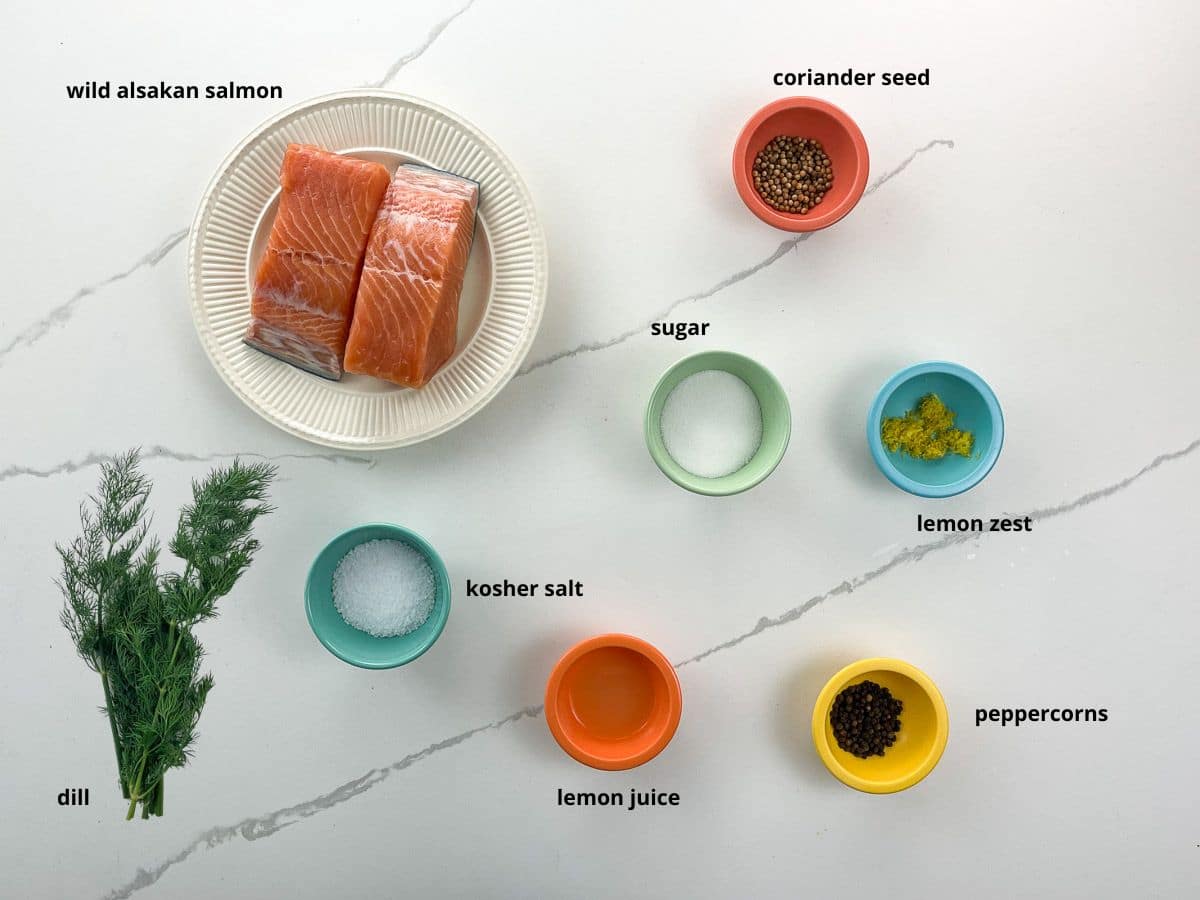
The salmon
- I always choose wild salmon over farmed salmon. I especially like to use king salmon (chinook) for gravlax since its texture is beautifully delicate, but MSC-certified wild sockeye, coho, and king salmon from Alaska are all fine choices.
- It’s very important to buy your salmon from a source you trust. It’s also great if it’s been flash-frozen to kill any parasites, as most wild salmon is in the off-season.
- For the holidays, I like to buy a beautiful whole fillet that hasn’t been cut into pieces, just because it looks pretty and feels a little special. You don’t have to go this route if you’d prefer to work with individual portions.
- Ask the fishmonger to remove the pin bones for you (or do it yourself with tweezers), and leave the skin on.
The cure
- A little bit of freshly squeezed lemon juice brushed evenly over the fish provides flavor and curing power and helps the dry cure adhere to the fillet. If you’d rather, you can use an equal amount of either vodka or gin instead.
- Because wild salmon is substantially leaner than farmed salmon, I like to use an equal ratio by weight of sugar to kosher salt. That’s a higher proportion of sugar than you might expect, but this and a relatively short curing time yields a soft and not overly dense result.
- Lemon zest, peppercorns, and coriander seeds make a lovely and classic set of seasonings.
- You’ll top things off with plenty of fresh dill. No need to chop it or remove the stems.
How to make it
Here’s an overview of how to cure salmon. You can see the steps in action in the video that accompanies this post, and get all the details in the recipe card below.
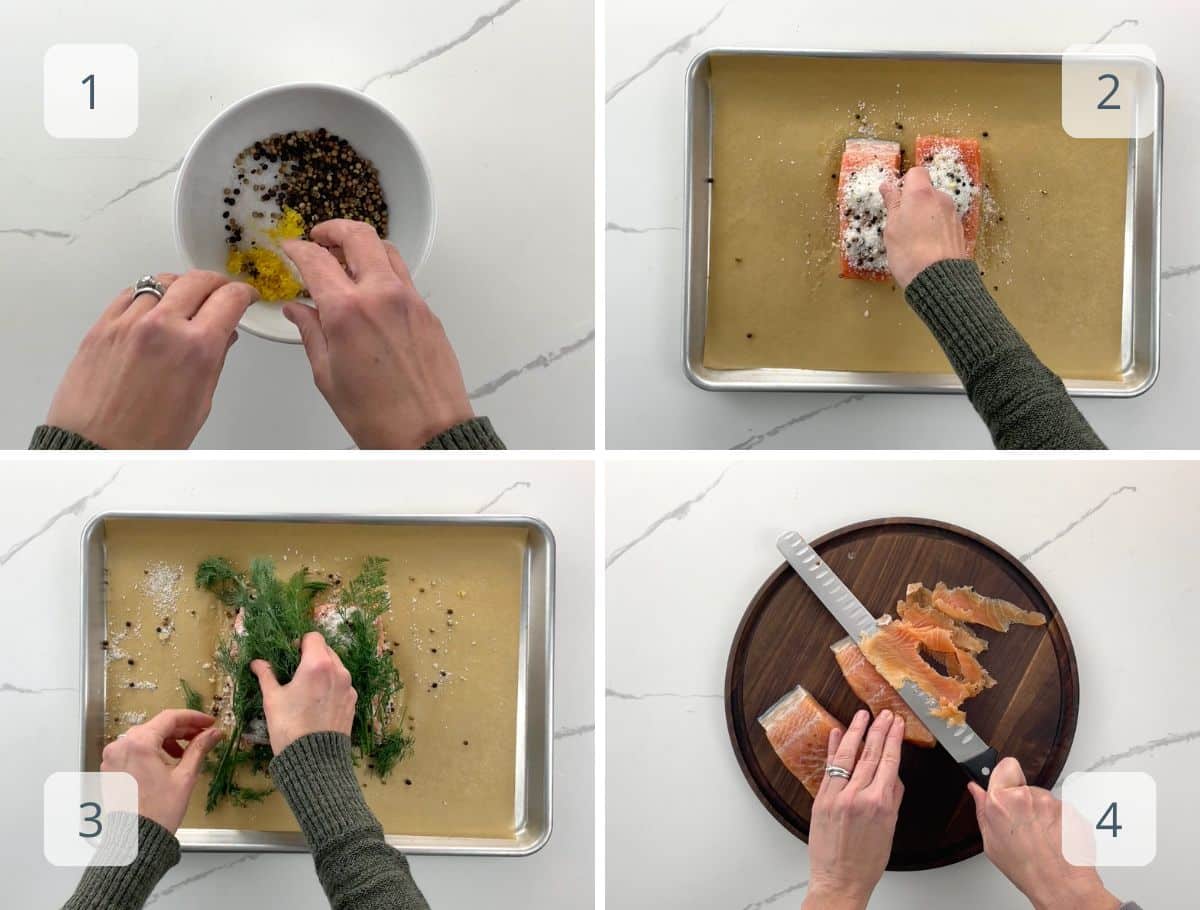
- First you’ll make the simple curing mixture.
- Place the salmon onto a parchment-lined half sheet pan, brush with the lemon juice, and coat evenly with the curing mixture.
- Lay the dill overtop. Cover with another layer of parchment and a second baking sheet. Weight with two large cans.
- Cure in the refrigerator for about 48 hours (for thick fillets) — start checking after 24 hours for thinner salmon.
How to serve it
Gravlax makes a beautiful centerpiece for an appetizer or bagel platter. You can include anything from traditional Scandinavian accompaniments like brown bread and mustard sauce, to any of your favorite smoked salmon accompaniments — chopped hard-boiled egg, minced red onion, capers, and tomato.
Or incorporate gravlax into one of my favorite recipes:
Slicing gravlax
Here’s a video showing the slicing process at regular speed. I won’t be winning any awards for this performance, but it’s good enough to make delicious, thin slices of gravlax. When you cure a whole fillet rather than a portion, you can make the slices bigger than the ones here without changing the angle.
Expert tips and FAQs
Slicing is the trickiest part of this recipe by far. It takes a little bit of practice, but you’ll be ahead of the game if you start with the right knife. A blade like this one is very thin, extremely sharp, and a little bit flexible. You’ll use it to cut the salmon on the bias. Once you make the initial cut for each slice, the key to achieving thinness is to feel like you’re applying more upward than downward pressure (even if this isn’t strictly accurate). You can see this step in action in the video clip above.
Yes. You’ll need to start at least 48 hours in advance to give the salmon a chance to cure. Once you’ve removed the cure, the salmon will keep, wrapped tightly, in the fridge for up to five days. Remove from the fridge and slice shortly before serving.
More next-level seafood appetizers
- Oysters with mignonette granita
- Truly the best shrimp cocktail
- Baked oysters with shallot herb butter
- Prosciutto-wrapped shrimp with garlic-sage butter
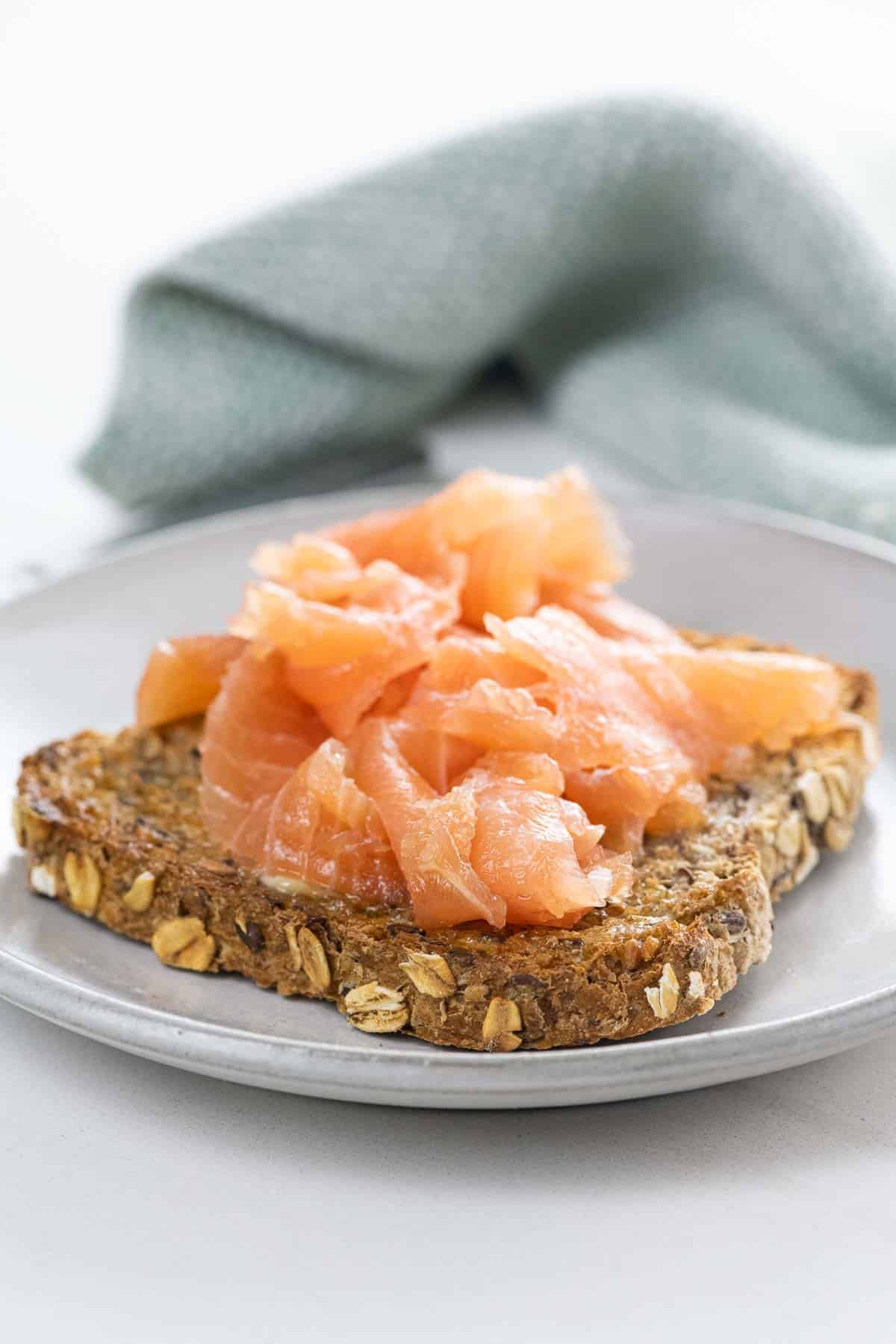
Hungry for more?
Subscribe to Umami Girl’s email updates, and follow along on Instagram.
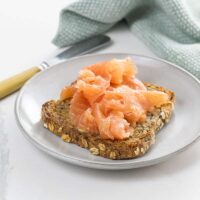
How to Cure Salmon (Gravlax Recipe)
Ingredients
- 2 pounds (907 grams) wild Alaskan salmon fillet, skin on
- 1 tablespoon (8 grams) whole black peppercorns
- 1 tablespoon (5 grams) whole coriander seeds
- 100 grams 1/2 cup granulated sugar
- 100 grams kosher salt, 7 tablespoons Mortons or 11 tablespoons Diamond Crystal
- 1 tablespoon finely grated lemon zest
- 2 tablespoons (30 ml) freshly squeezed lemon juice
- 1 large bunch fresh dill, about 4 ounces/(113 grams)
Instructions
- If the salmon contains any pin bones, remove them with tweezers.
- Crack the peppercorns and coriander seeds. You can give them a very brief spin (just a second or two) in a spice grinder or simply place them onto the rimmed half sheet pan and use the back of a heavy skillet to crush them a bit.
- Place cracked spices into a small mixing bowl. Line the rimmed half sheet pan with parchment paper.
- To the mixing bowl, add the sugar, salt, and lemon zest. Use the tips of your fingers to gently rub the ingredients together and mix them up.
- Place the salmon, skin side down, on the parchment-lined sheet pan. Brush evenly with the lemon juice.
- Sprinkle the salt mixture over the salmon, covering completely. If your fillet has thicker and thinner sections, apply the mixture a little more heavily where the salmon is thicker and more lightly where the fillet thins out toward the tail.
- Cover evenly with the dill.
- Cover the salmon with another layer of parchment and then another sheet pan. Weight the top sheet pan with two 16-ounce cans.
- Refrigerate for 48 hours if using thick fillets like the ones pictured. Start checking at the 24 hour mark for thinner cuts. Your preferred level of cure is somewhat of a personal matter, but a visible reduction in volume and plenty of liquid in the pan are good indications that the salmon is ready. The outside faces of the fillets may appear a little bit dense, but the salmon should be beautifully tender when you slice it.
- Scrape the dill and curing mixture from the salmon. Rinse well and pat dry.
- With a very sharp knife, slice very thinly on the bias to serve.
Notes
- I always choose wild salmon over farmed salmon. I especially like to use king salmon (chinook) for gravlax since its texture is beautifully delicate, but MSC-certified wild sockeye, coho, and king salmon from Alaska are all fine choices.
- It's very important to buy your salmon from a source you trust. It's also great if it's been flash-frozen to kill any parasites, as most wild salmon is in the off-season.
- For the holidays, I like to buy a beautiful whole fillet that hasn't been cut into pieces, just because it looks pretty and feels a little special. You don't have to go this route if you'd prefer to work with individual portions.
- Ask the fishmonger to remove the pin bones for you (or do it yourself with tweezers), and leave the skin on.
- A little bit of freshly squeezed lemon juice brushed evenly over the fish provides flavor and curing power and helps the dry cure adhere to the fillet. If you'd rather, you can use an equal amount of either vodka or gin instead.
- Because wild salmon is substantially leaner than farmed salmon, I like to use an equal ratio by weight of sugar to kosher salt. That's a higher proportion of sugar than you might expect, but this and a relatively short curing time yields a soft and not overly dense result.
- This is a good recipe to prep ahead. You'll need to start at least 48 hours in advance to give the salmon a chance to cure. Once you've removed the cure, the salmon will keep, wrapped tightly, in the fridge for up to five days. Remove from the fridge and slice shortly before serving.
Nutrition
Nutrition information is automatically calculated, so should only be used as an approximation.
Hungry for more?
Subscribe to Umami Girl’s email updates, and follow along on Instagram.
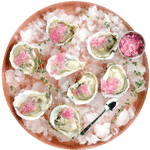
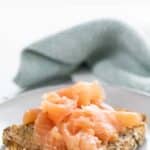
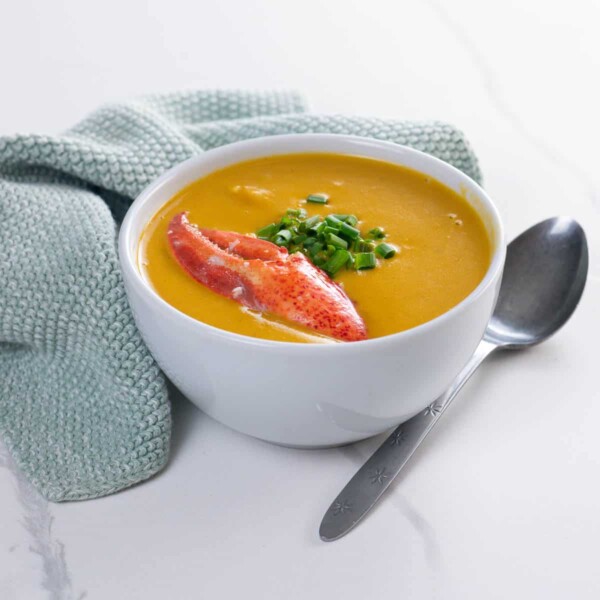
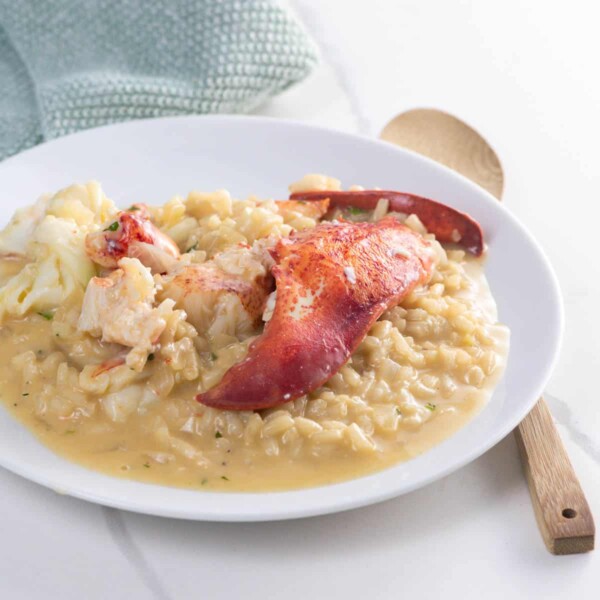
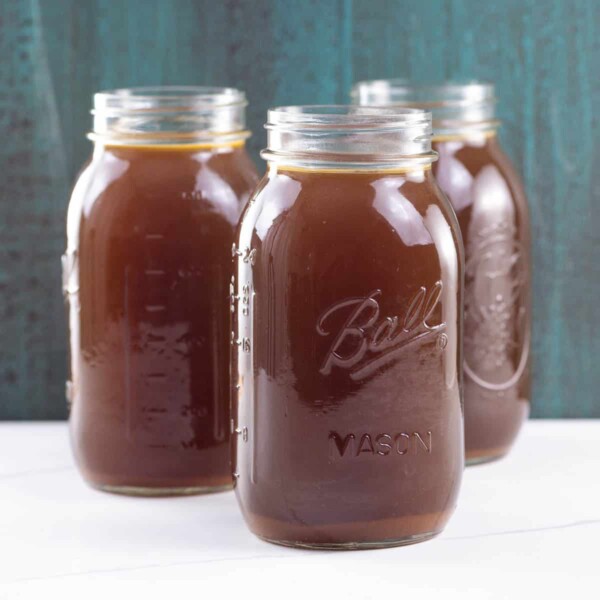
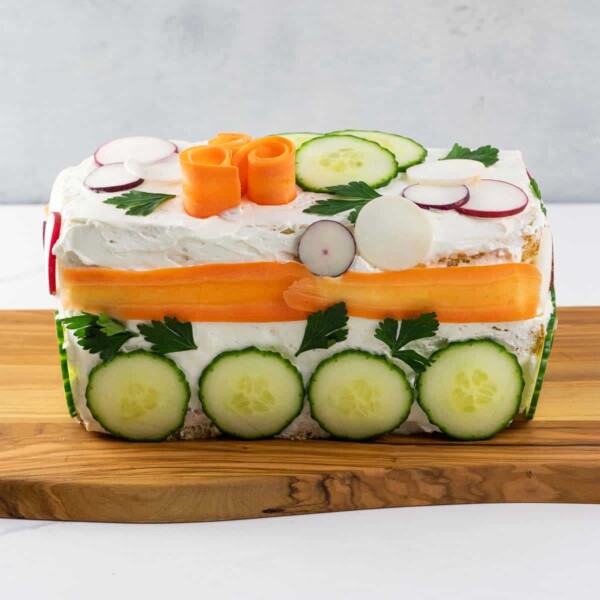







Being of Nordic background this is how my family made it and how I always make it too. Sometimes a crack pepper medley, grated rind of the lemon in addition to the lemon juice, and fine minced onion are also added too. It never cures it for more than 36 hours, and always only made with fresh wild salmon. It’s served with bowls of sour cream, mustard, horseradish, chopped onions (if you didn’t add it already to the original recipe), capers, and triangles of grovbrød, so everyone can help themselves and put whatever they want on it. For special occasions like Christmas, a bowl of caviar is also added to the buffet. Thanks for letting everyone know about this fantastic treat.
Love it, Ana. Thanks for the comment. xx
Hi, I have a question about the freezing of the salmon. If you buy it fresh do you then freeze it and then take it out frozen and add the salt suger and other ingredients while its still frozen or do you let it dethaw first then add the ingredients? Could you email me your answer at [email protected] thank you so much!
Umamigirl,
I have been searching for a basic recipe for gravlax. Thank you for sharing yours.
I tried this for Christmas dinner and everyone loved it. I tried this with a frozen sockeye salmon fillet and it was great!
Thanks again.
This looks fantastic. My mother cures an entire salmon for Christmas dinner every year, but I’ve never tried it myself. Maybe I should volunteer to take over Gravlax duties this year!
I’ve been dying to try this, and really, I have no excuse, looks so simple. Wish I was at your Thanksgiving – gosh, I wouldn’t have had any room left for turkey!
Awesome work! Definitely hope to give this a shot over the holidays.
Cheers,
Nick
Hi Diana, thanks! You know, I didn’t even bother to chop the dill. It’s easier to remove that way. You might discard the thick stems so they don’t leave imprints on the salmon, but other than that, keep it simple.
ok, this is amazing, and you’re right, amazingly simple. Did you chop up the dill?